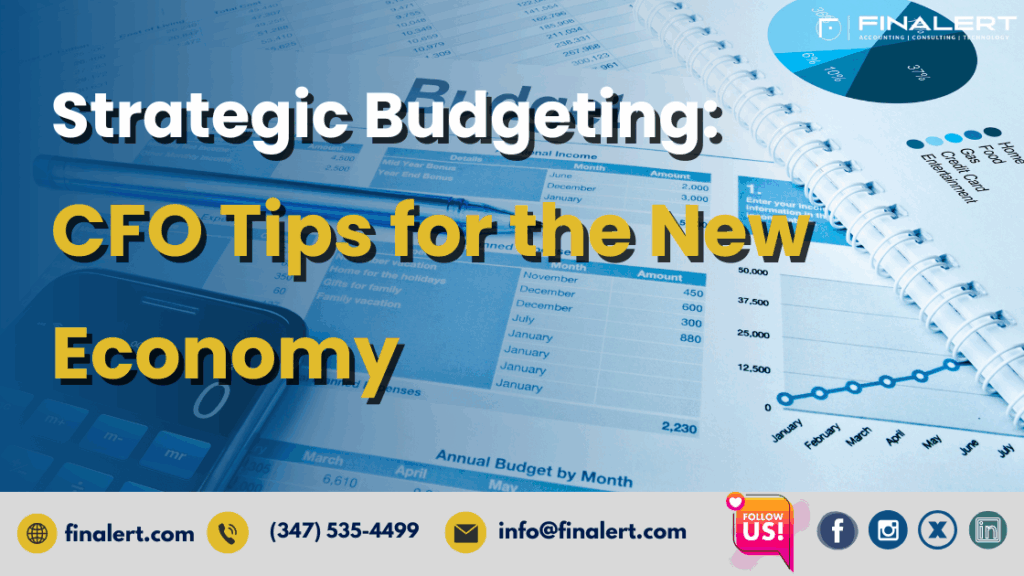
Strategic budgeting has become a critical discipline for CFOs navigating the new economy in 2025. With shifting market conditions, evolving customer behaviors, and rapid technological change, traditional static budgets often fall short. Today’s CFOs are building dynamic, flexible budgets that align financial resources with real-time business priorities. The focus is no longer just on controlling costs; it’s about enabling growth, managing risk, and ensuring resilience in an unpredictable environment.
This article explores the budgeting strategies top CFOs are using to optimize cash flow, prioritize high-impact investments, and adjust plans quickly in response to market shifts—equipping businesses to thrive, not just survive, in the new economy.
In the past, annual budgets were set at the start of the year and rarely revisited. While predictable in theory, this approach has proven inadequate for the post-pandemic, technology-driven, and inflation-sensitive economy. The “new economy” is defined by:
A strategic budget equips CFOs and business leaders to plan for multiple scenarios, allocate resources effectively, and stay financially agile.
A successful strategic budgeting process in the new economy follows these foundational principles:
Every dollar in the budget should support strategic priorities—whether that’s market expansion, technology upgrades, or talent retention. CFOs must bridge the gap between financial planning and operational execution.
Budgets should include contingency funds and adaptable cost structures, enabling quick responses to market changes without derailing the overall strategy.
Leveraging real-time data analytics allows CFOs to monitor performance against budget and adjust proactively rather than reactively.
Strategic budgeting is not solely a finance department exercise. Sales, marketing, operations, HR, and product teams should have input to ensure plans are realistic and aligned.
Budgeting is as much about managing downside risk as it is about funding opportunities. This means identifying vulnerabilities—such as supply chain reliance on one vendor—and planning financial buffers accordingly.
Start by analyzing revenue, expenses, and profitability trends from previous years. Identify which trends are likely to continue, which are temporary, and which could reverse. Use this insight as a baseline for forecasting.
CFO Tip: Don’t assume last year’s growth rate will repeat. Adjust projections for economic indicators, market competition, and industry-specific developments.
Work with leadership to clarify the top 3–5 strategic priorities for the year. Examples include:
These priorities will guide allocation decisions throughout the budget.
Instead of one revenue forecast, prepare at least three:
This approach allows the business to pivot more effectively.
Evaluate every major expense against its expected return. In a constrained environment, capital should flow to the initiatives with the strongest impact on profitability or strategic advantage.
Example: A SaaS company might allocate more budget to customer success teams if data shows retention improvements have a higher ROI than additional marketing spend.
Separate expenses into:
This categorization ensures flexibility when financial adjustments are required.
Set aside a percentage of the budget, often 3–5%, as a contingency fund for unexpected costs. In the new economy, this is essential for absorbing supply chain disruptions, compliance changes, or sudden market opportunities.
A strategic budget is a living document. CFOs should review budget-to-actual performance monthly and adjust allocations as needed. This may involve shifting funds between departments or accelerating/decelerating projects.
Modern financial software integrates with sales, inventory, and HR systems, enabling CFOs to see up-to-date figures instantly. This visibility helps identify cost overruns or revenue shortfalls early.
CFOs are directing funds toward initiatives that directly support growth or risk reductions as AI-driven analytics, cybersecurity enhancements, and workforce development programs.

Instead of setting a fixed 12-month plan, rolling forecasts update every quarter (or even monthly) based on the latest data, ensuring decisions are always relevant to current conditions.
Strategic budgeting extends beyond expenses to cash flow management. CFOs are tightening receivables processes, negotiating better payment terms, and streamlining inventory to free up cash.
Comparing expense ratios, margins, and productivity metrics to industry averages helps identify areas where spending may be too high or investment too low.
In the new economy, the CFO is no longer a back-office financial gatekeeper. They are:
By leading the strategic budgeting process, CFOs help organizations navigate uncertainty while positioning for sustainable success.
Strategic budgeting in 2025 is about far more than tracking expenses—it’s about aligning resources with vision, adapting quickly to change, and making informed, proactive decisions. In the new economy, where market conditions can shift in days, a well-crafted, flexible budget is one of the most powerful tools a business has to remain competitive.
For U.S. companies, adopting the principles and practices outlined here, such as scenario planning, ROI-driven allocations, rolling forecasts, and collaborative planning, can mean the difference between reacting to market pressures and leading confidently through them. The CFO’s role in this process is indispensable, ensuring that every budgeting decision moves the business closer to its strategic goals while safeguarding its financial health.
Similar Articles
No results available
Get in touch with Finalert today for tailored business solutions!
No results available
Ready to thrive? Connect with Finalert today and let’s succeed together in the dynamic global market.
© 2025 Finalert. All rights reserved.
Ready to thrive in the dynamic global market? Finalert LLC offers expert financial services, including accounting, consulting, and technology solutions, tailored to your business needs.
Address
Accounting
Quick Links
Consulting
Industries
© 2025 Finalert LLC. All rights reserved.